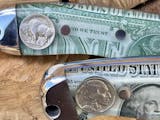N690 Stainless Steel
Introducing N690 stainless steel Produced by Bohler-Uddenholm — a high hardness, fine-grained option for knifemakers. Comparable to AEB-L, 12C27, and 14C28N, this premium steel offers exceptional corrosion resistance, superior toughness, and excellent fine edge retention. N690 stands out for its exceptional metallurgical properties, including a high carbon content and a refined grain structure, resulting in enhanced strength and durability. With its outstanding sharpness and edge retention, N690 steel elevates the quality of knives to new levels. Its forge or kiln heat-treatability ensures optimal performance and allows for fine-tuning to meet specific requirements, making N690 a preferred choice for achieving exceptional craftsmanship in knifemaking.
Alloying Content
-
Carbon - 1.07%
-
Chromium - 17.3%
-
Molybdenum - 1.1%
-
Vanadium - 0.10%
-
Cobolt- 1.50%
-
Manganese - 0.4%
-
Silicon - 0.4%
-
Iron - Balance
Toughness 8/10 – N690 stainless steel exhibits high toughness, surpassing the majority of stainless steels and carbon/tool steels. It is well-suited for blades of varying sizes, from delicate scalpels and razors to robust machetes and swords.
Edge retention 7/10 – N690 offers superior edge retention compared to most carbon steels and falls slightly behind some stainless steels. While it may blunt relatively easily due to abrasive wear, it showcases exceptional edge stability, resisting chipping and rolling. Its lower abrasive wear resistance also grants it the advantage of easier grinding, hand sanding, and polishing, particularly when compared to stainless steel alloys high in vanadium.
Corrosion resistance 8/10 – N690 demonstrates commendable resistance to rust, comparable to other widely used stainless steels such as AEB-L, CPM 154, and Nitro-V. Its corrosion resistance ensures durability and longevity, even in demanding environments.
Recommended Heat Treatment
- Coat blade in an anti scale compound or seal in double crimped 321 or 309 grade stainless steel tool wrap
- Austenitise at 1050-1100°C and hold for 10 minutes.
- Quench between aluminium plates, or air quench
- Immerse in liquid nitrogen or a dry ice slurry or place in a kitchen freezer for 1 hour or more – the lower the temperature the more austenite will be converted to martensite and the higher the as-quenched hardness will be
- Temper at 150-230°C for 2 hours, twice, depending on desired hardness





















